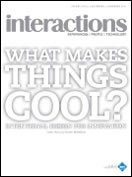Authors:
Alex Howard
In the 1990s, the Internet changed communication and commerce forever. A decade later, the Web 2.0 revolution enabled a new disruption in media by democratizing the tools for publishing. Citizens without specialized technical skills can now easily upload pictures, video, and text to a more interactive Web, where they can then use powerful new platforms to share, mix, and comment upon it all. In the years since the first social networks went online, the disruption presented by this dynamic online environment, fed by faster Internet connections and a global explosion of mobile users, has created shifts in the power…
You must be a member of SIGCHI, a subscriber to ACM's Digital Library, or an interactions subscriber to read the full text of this article.
GET ACCESS
Join ACM SIGCHIIn addition to all of the professional benefits of being a SIGCHI member, members get full access to interactions online content and receive the print version of the magazine bimonthly.
Subscribe to the ACM Digital Library
Get access to all interactions content online and the entire archive of ACM publications dating back to 1954. (Please check with your institution to see if it already has a subscription.)
Subscribe to interactions
Get full access to interactions online content and receive the print version of the magazine bimonthly.







Post Comment
No Comments Found